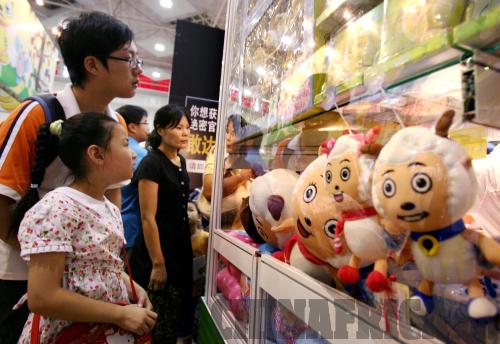The success of Pleasant Goat and Big Big Wolf has made Chinese investors realize that producing a moneymaking blockbuster does not require overpriced movie stars or gorgeous actresses, or even a real person. Since its debut in 2005, the 2D cartoon TV series attracted viewers with stories about clever lambs outwitting clumsy wolves, and was soon made into five films, garnering ticket revenues of over 700 million yuan ($114 million).
A great number of animated characters are now following in the footsteps of these goats and wolves and making their way onto Chinese screens. China's animation industry has now become one of the hottest investment sectors in China. As the market booms, the industry's annual output has skyrocketed, reaching 76 billion yuan ($12.4 billion) in 2012, according to the Ministry of Culture.
Industrial chain
At this year's China International Comics and Games Expo (CCG Expo) held in July in Shanghai, Oriental DreamWorks garnered a lot of attention with a 5-meter-high Kungfu Panda statue. Many animation fans might not know about the company, but its logo - a panda sitting on the moon fishing for dreams - may be familiar.
The Shanghai-based Oriental DreamWorks is a joint venture established in 2012, owned 45 percent by DreamWorks and 55 percent by Chinese companies. It's the largest of international investment project in China's entertainment sector to date.
According to DreamWorks CEO Jeffrey Katzenberg, the decision to launch the joint venture was based on strong confidence in the Chinese animation market. Its latest blockbuster, The Croods, has generated over 391 million yuan ($63 million) at the Chinese box office.
Since 2006, the Chinese Government has made a series of policies to promote the animation industry by offering industry investments, tax incentives, and stricter enforcement of copyright regulations. It's also listed in the country's 12th Five-Year Plan, a blueprint which outlines key economic and development targets for the country from 2011 to 2015.
China is now home to over 500 animation enterprises, 13 of which have assets worth over 1.3 billion yuan ($213 million). "Profit mode is the foundation of the animation business," commented Chen Shaofeng, Vice President of the Institute for Cultural Industries at Peking University. Some professionals believe that revenue from TV stations accounts for only 30 percent of an animated work's profits.
"Sometimes it's even lower," said Li Huisheng, a Strategic Development Counselor at Wanhao Cartoon, a leading animation company based in Beijing. "So it's important to develop an industrial chain in which derivative products play a major role."
During the five-day CCG Expo, 35 million yuan ($5.6 million) was spent on animation derivative products, including clothing, toys and stationery, an average of 164 yuan ($26.8) per expo attendee.
Wanhao Cartoon now works with 14 toy manufacturers and two candy manufacturers. Li said that when scripts for TV shows or movies are written, the writers keep the possibility of creating derivative products in mind to make sure that the design of the characters and plot can be templates for toys and other products.
"But still, 70 percent of our efforts should be focused on our stories, which are the foundation of all commercial operations," said Li.

Pleasant Goat and Big Big Wolf
Creativity enhancement
China has surpassed the United States and Japan to become the world's largest animation producer in terms of annual output. A total of 270,000 minutes of animated works were produced in 2011, according to the State Administration of Radio, Film and Television.
"Now the Chinese animation industry is at a turning point, changing from focusing on quantity to quality," Li said. Despite its rapid growth, the still-developing Chinese animation industry has been plagued by a lack of originality and creativity.
"My generation spent all of its childhood and teenage years under the influence of Japanese animation," said Wang Jiali, a 23-year-old student. "Good Chinese animations that can impress audiences are rare." Chinese animations have created thousands of cartoon characters, but few have made an impression on audiences.
"In terms of creativity, there was not much progress in past years, which can be a barrier for commercial operation," said Hu Rong, one of the most successful prize-winning comic authors in China who is currently working in Japan. There are more than 2,400 colleges in China that offer training in animation production, but the number of talented individuals who have mastered the art of good story telling has remained low.
"Everyone is talking about the market, animation or games, but the creation of original stories is neglected," said Hu, who believes that comics and animation are just tools for expressing oneself, and that it's important for authors to use them to tell Chinese stories.
Qin's Moon, a CG animated TV series that tells the ancient Chinese story of the rise and fall of Qin Dynasty (221-206 B.C.), has been one of the most successful animation works in recent years, and has attracted both domestic and overseas adult audiences. It has been shown in 37 countries and regions. According to its producer Yang Zhichao, the company has asked its U.S. distributor whether it's necessary to make adjustments to cater to the tastes of American audiences, but they were told that it's the original Chinese elements that American audiences want to see.
Those programs that use Chinese culture as their inspiration usually stand out. In the 1940s, China produced several internationally renowned animated films based on Chinese traditional stories. These films influenced Tezuka Osamu, the most important figure in the Japanese animation history.
The success of Kungfu Panda shows the potential of Chinese culture in the animation industry, but it also acts as a harsh reminder to Chinese audiences that China had nothing to do with creating the world's most popular panda story.
But there might be good news. In Kungfu Panda 3, which will debut in 2015, the panda hero Po will find his way home the movie will be made in China as a co-production with Oriental DreamWorks. CA